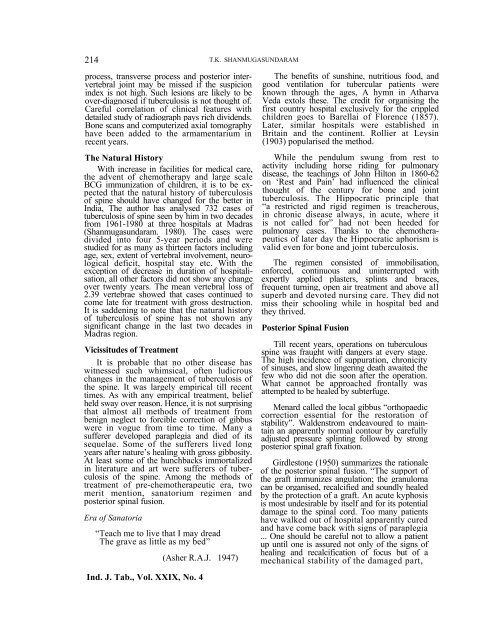October - LRS Institute of Tuberculosis & Respiratory Diseases
October - LRS Institute of Tuberculosis & Respiratory Diseases
October - LRS Institute of Tuberculosis & Respiratory Diseases
You also want an ePaper? Increase the reach of your titles
YUMPU automatically turns print PDFs into web optimized ePapers that Google loves.
214 T.K. SHANMUGASUNDARAM<br />
process, transverse process and posterior intervertebral<br />
joint may be missed if the suspicion<br />
index is not high. Such lesions are likely to be<br />
over-diagnosed if tuberculosis is not thought <strong>of</strong>.<br />
Careful correlation <strong>of</strong> clinical features with<br />
detailed study <strong>of</strong> radiograph pays rich dividends.<br />
Bone scans and computerized axial tomography<br />
have been added to the armamentarium in<br />
recent years.<br />
The Natural History<br />
With increase in facilities for medical care,<br />
the advent <strong>of</strong> chemotherapy and large scale<br />
BCG immunization <strong>of</strong> children, it is to be expected<br />
that the natural history <strong>of</strong> tuberculosis<br />
<strong>of</strong> spine should have changed for the better in<br />
India, The author has analysed 732 cases <strong>of</strong><br />
tuberculosis <strong>of</strong> spine seen by him in two decades<br />
from 1961-1980 at three hospitals at Madras<br />
(Shanmugasundaram. 1980). The cases were<br />
divided into four 5-year periods and were<br />
studied for as many as thirteen factors including<br />
age, sex, extent <strong>of</strong> vertebral involvement, neurological<br />
deficit, hospital stay etc. With the<br />
exception <strong>of</strong> decrease in duration <strong>of</strong> hospitalisation,<br />
all other factors did not show any change<br />
over twenty years. The mean vertebral loss <strong>of</strong><br />
2.39 vertebrae showed that cases continued to<br />
come late for treatment with gross destruction.<br />
It is saddening to note that the natural history<br />
<strong>of</strong> tuberculosis <strong>of</strong> spine has not shown any<br />
significant change in the last two decades in<br />
Madras region.<br />
Vicissitudes <strong>of</strong> Treatment<br />
It is probable that no other disease has<br />
witnessed such whimsical, <strong>of</strong>ten ludicrous<br />
changes in the management <strong>of</strong> tuberculosis <strong>of</strong><br />
the spine. It was largely empirical till recent<br />
times. As with any empirical treatment, belief<br />
held sway over reason. Hence, it is not surprising<br />
that almost all methods <strong>of</strong> treatment from<br />
benign neglect to forcible correction <strong>of</strong> gibbus<br />
were in vogue from time to time. Many a<br />
sufferer developed paraplegia and died <strong>of</strong> its<br />
sequelae. Some <strong>of</strong> the sufferers lived long<br />
years after nature’s healing with gross gibbosity.<br />
At least some <strong>of</strong> the hunchbacks immortalized<br />
in literature and art were sufferers <strong>of</strong> tuberculosis<br />
<strong>of</strong> the spine. Among the methods <strong>of</strong><br />
treatment <strong>of</strong> pre-chemotherapeutic era, two<br />
merit mention, sanatorium regimen and<br />
posterior spinal fusion.<br />
Era <strong>of</strong> Sanatoria<br />
“Teach me to live that I may dread<br />
The grave as little as my bed”<br />
(Asher R.A.J. 1947)<br />
Ind. J. Tab., Vol. XXIX, No. 4<br />
The benefits <strong>of</strong> sunshine, nutritious food, and<br />
good ventilation for tubercular patients were<br />
known through the ages, A hymn in Atharva<br />
Veda extols these. The credit for organising the<br />
first country hospital exclusively for the crippled<br />
children goes to Barellai <strong>of</strong> Florence (1857).<br />
Later, similar hospitals were established in<br />
Britain and the continent. Rollier at Leysin<br />
(1903) popularised the method.<br />
While the pendulum swung from rest to<br />
activity including horse riding for pulmonary<br />
disease, the teachings <strong>of</strong> John Hilton in 1860-62<br />
on ‘Rest and Pain’ had influenced the clinical<br />
thought <strong>of</strong> the century for bone and joint<br />
tuberculosis. The Hippocratic principle that<br />
“a restricted and rigid regimen is treacherous,<br />
in chronic disease always, in acute, where it<br />
is not called for” had not been heeded for<br />
pulmonary cases. Thanks to the chemotherapeutics<br />
<strong>of</strong> later day the Hippocratic aphorism is<br />
valid even for bone and joint tuberculosis.<br />
The regimen consisted <strong>of</strong> immobilisation,<br />
enforced, continuous and uninterrupted with<br />
expertly applied plasters, splints and braces,<br />
frequent turning, open air treatment and above all<br />
superb and devoted nursing care. They did not<br />
miss their schooling while in hospital bed and<br />
they thrived.<br />
Posterior Spinal Fusion<br />
Till recent years, operations on tuberculous<br />
spine was fraught with dangers at every stage.<br />
The high incidence <strong>of</strong> suppuration, chronicity<br />
<strong>of</strong> sinuses, and slow lingering death awaited the<br />
few who did not die soon after the operation.<br />
What cannot be approached frontally was<br />
attempted to be healed by subterfuge.<br />
Menard called the local gibbus “orthopaedic<br />
correction essential for the restoration <strong>of</strong><br />
stability”. Waldenstrom endeavoured to maintain<br />
an apparently normal contour by carefully<br />
adjusted pressure splinting followed by strong<br />
posterior spinal graft fixation.<br />
Girdlestone (1950) summarizes the rationale<br />
<strong>of</strong> the posterior spinal fusion. “The support <strong>of</strong><br />
the graft immunizes angulation; the granuloma<br />
can be organised, recalcified and soundly healed<br />
by the protection <strong>of</strong> a graft. An acute kyphosis<br />
is most undesirable by itself and for its potential<br />
damage to the spinal cord. Too many patients<br />
have walked out <strong>of</strong> hospital apparently cured<br />
and have come back with signs <strong>of</strong> paraplegia<br />
... One should be careful not to allow a patient<br />
up until one is assured not only <strong>of</strong> the signs <strong>of</strong><br />
healing and recalcification <strong>of</strong> focus but <strong>of</strong> a<br />
mechanical stability <strong>of</strong> the damaged part,

















